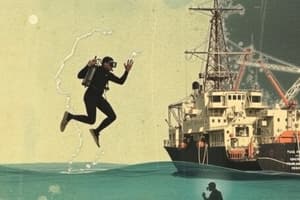Podcast
Questions and Answers
In the described incident, what direct action led the Diving Supervisor to incorrectly assume the crane hook had reached the seabed?
In the described incident, what direct action led the Diving Supervisor to incorrectly assume the crane hook had reached the seabed?
- The crane operator stated there was 'no weight' on the crane wire. (correct)
- The PHF shifted unexpectedly on the seabed.
- The diver reported that there was slack in the rigging.
- The underwater camera feed was temporarily lost.
Which of the following is the MOST direct preventative measure to avoid incidents like the one described?
Which of the following is the MOST direct preventative measure to avoid incidents like the one described?
- Increased dive team size to improve coordination.
- Mandatory helmet checks before each dive.
- Sufficient crane pennant/stinger length to ensure adequate distance between divers and the crane hook. (correct)
- Detailed mapping of the seabed to avoid obstacles.
Besides inadequate equipment, what additional factor significantly contributed to the accident?
Besides inadequate equipment, what additional factor significantly contributed to the accident?
- Poor visibility hindering the ability to accurately observe the position of the crane hook. (correct)
- Incorrect emergency response procedures.
- Failure of the diver's communication system.
- Poor weather conditions on the surface.
What immediate actions demonstrated proper safety response following the incident?
What immediate actions demonstrated proper safety response following the incident?
How could enhanced monitoring MOST effectively improve safety in similar subsea operations?
How could enhanced monitoring MOST effectively improve safety in similar subsea operations?
Flashcards
Crane Hook Strikes Diver Helmet
Crane Hook Strikes Diver Helmet
During subsea spool tie-in operations, a crane hook unexpectedly struck a diver's helmet, causing damage. The diver was unharmed due to helmet integrity.
Causes of the Incident
Causes of the Incident
Inadequate crane pennant/stinger length and poor visibility hindered the ability to accurately observe the crane hook's position, leading to the incident.
Prevention Measures
Prevention Measures
Ensure adequate distance between divers and the crane hook by using a sufficient pennant/stinger length. Use enhanced visibility aids and monitoring.
Importance of Communication
Importance of Communication
Signup and view all the flashcards
The Role of Assumptions
The Role of Assumptions
Signup and view all the flashcards
Study Notes
- During subsea spool tie-in operations, a diver's helmet was struck by a crane hook
What Happened?
- Divers were working on the seabed in poor visibility during subsea spool tie-in operations
- After the pipe handling frame (PHF) landed, the Diving Supervisor instructed the crane operator to lower the crane hook to allow the diver to disconnect rigging
- The crane operator reported 'no weight' on the crane wire
- The Diving Supervisor assumed the hook had reached the seabed and instructed the diver to proceed with disconnecting the PHF
- While positioned beneath the PHF, the crane hook unexpectedly struck the diver's helmet as the diver moved to disconnect the rigging
- The diver reported being unharmed and returned to the dive bell
- The dive was aborted
- Inspection revealed the diver's reclaim helmet had damage beyond repair, including the side block
- The helmet's integrity was maintained, this shows the durability of diving helmets
- The diver was unharmed
What Went Right?
- Diver 2 promptly assisted Diver 1, with no injuries sustained
- Both divers immediately returned to the bell safely
- Locating beacons fixed to both divers and the crane block enabled accurate tracking
- All procedures, lifting plans, and Job Hazard Analysis (JHA's) were followed throughout the operation
- The diver was uninjured because the protective equipment absorbed the impact
What Went Wrong?
- The crane hook came to rest on the top beam of the PHF when lowered for rigging disconnection
- This caused a 'no weight' reading, leading the crane operator to think the hook had reached the seabed
- The hook slipped off the beam and struck the side of the diver's helmet as the diver approached the disconnection point
What Was the Cause?
- Inadequate length of crane pennant, which did not provide enough distance between the divers and the crane hook
- Poor visibility, hindering the ability to accurately observe the crane hook's position
Lessons and Actions
- Maintain adequate distance between divers and crane hook
- The length of the crane pennant should be sufficient to maintain a safe distance between divers and the crane hook during subsea operations to reduce the risk of accidental contact, especially in limited visibility
- Enhanced visibility aids and monitoring is essential
- Use alternative methods such as additional locating beacons, underwater cameras, or sonar in low visibility to track the position of critical equipment like the crane hook
- Improved monitoring can prevent misjudgments about the location of the crane hook
- Reinforce communications and challenge assumptions
- Assumptions about equipment position should be minimised
- Clear communication and confirmation procedures between the dive supervisor, crane operator, and divers should be reinforced
- All parties should be fully aware of the equipment's location
Additional Member Actions
- Updated project procedures to specify minimum pennant lengths for different operations
- Conducted pre-operation inspections of all rigging and lifting equipment, including crane hooks and pennants, to ensure they meet safety standards
- Updated the Job Hazard Analysis (JHA) to incorporate lessons learned from this incident, regarding safe distances, visibility, and communication requirements for subsea lifting operations
Studying That Suits You
Use AI to generate personalized quizzes and flashcards to suit your learning preferences.




